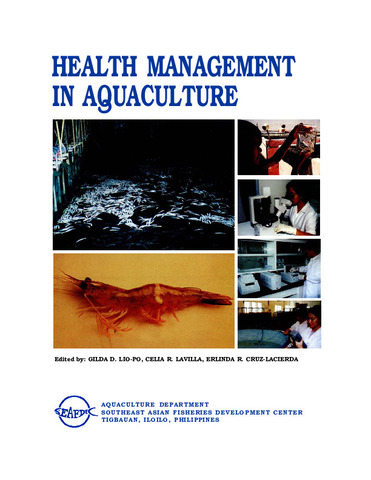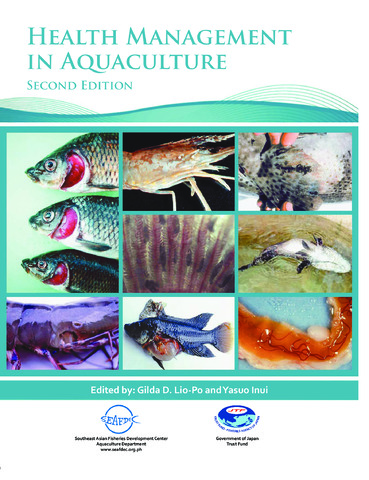Diseases affecting wild and farmed mud crab in the Philippines
| dc.contributor.author | Tendencia, Eleonor | |
| dc.contributor.author | Cabilitasan, Ma. Venuz C. | |
| dc.contributor.editor | Quinitio, Emilia T. | |
| dc.contributor.editor | Parado-Estepa, Fe Dolores | |
| dc.contributor.editor | Coloso, Relicardo M. | |
| dc.date.accessioned | 2017-08-25T08:46:31Z | |
| dc.date.accessioned | 2017-08-25T16:30:41Z | |
| dc.date.available | 2017-08-25T08:46:31Z | |
| dc.date.available | 2017-08-25T16:30:41Z | |
| dc.date.issued | 2017 | |
| dc.identifier.citation | Tendencia, E. A., & Cabilitasan, M. V. C. (2017). Diseases affecting wild and farmed mud crab in the Philippines. In E. T. Quinitio, F. D. Parado-Estepa, & R. M. Coloso (Eds.), Philippines : In the forefront of the mud crab industry development : proceedings of the 1st National Mud Crab Congress, 16-18 November 2015, Iloilo City, Philippines (pp. 77-88). Tigbauan, Iloilo, Philippines: Aquaculture Department, Southeast Asian Fisheries Development Center. | en |
| dc.identifier.isbn | 9789719931072 | |
| dc.identifier.uri | http://hdl.handle.net/10862/3160 | |
| dc.description.abstract | Mortalities due to cannibalism and diseases have been reported as major problems in the grow-out phase of mud crab production. This study aimed to identify and describe diseases affecting farmed and wild mud crab (mangrove crab) including predisposing, risk and protective factors, and possible prevention and control measures. A total of 767 wild and farmed mud crab samples were collected. External examination showed abnormalities such as short abdominal flap, discoloration of the abdominal region, darker carapace, lesions on carapace, claws and legs, and presence of epibionts like algae and the barnacles Balanus sp. on the carapace. Internally, necrotic, black and brown gills, and discolored gonads were observed. Stalked barnacles, Octolasmis spp., were observed in the gills. White spot syndrome virus (WSSV) was detected in 14 samples sourced from farms and Infectious hypodermal and haematopoietic necrosis virus (IHHNV) in 2 wild samples. WSSV was implicated in mortality cases. Low temperature and presence of WSSV positive shrimp were identified as risk factors for WSSV infection or outbreak. Pathogenicity tests for some isolated bacteria suggested that these may cause mortality in mud crab under stressful conditions. To prevent mortality due to WSSV infection, it is recommended to avoid polyculture of mud crab with shrimp and/or other crustaceans. | en |
| dc.language.iso | en | en |
| dc.publisher | Aquaculture Department, Southeast Asian Fisheries Development Center | en |
| dc.subject | Scylla serrata | en |
| dc.subject | Philippines | en |
| dc.title | Diseases affecting wild and farmed mud crab in the Philippines | en |
| dc.type | Conference paper | en |
| dc.citation.spage | 77 | |
| dc.citation.epage | 88 | |
| dc.citation.conferenceTitle | Philippines : In the forefront of the mud crab industry development : proceedings of the 1st National Mud Crab Congress, 16-18 November 2015, Iloilo City, Philippines | en |
| dc.subject.asfa | malformations | en |
| dc.subject.asfa | bacterial diseases | en |
| dc.subject.asfa | cannibalism | en |
| dc.subject.asfa | crab culture | en |
| dc.subject.asfa | disease control | en |
| dc.subject.asfa | fish diseases | en |
| dc.subject.asfa | marine crustaceans | en |
| dc.subject.asfa | mortality | en |
| dc.subject.asfa | parasitic diseases | en |
| dc.subject.asfa | pathogens | en |
| dc.subject.asfa | polyculture (aquaculture) | en |
| dc.subject.asfa | disease prophylaxis | en |
| dc.subject.asfa | survival | en |
| dc.subject.asfa | temperature effects | en |
| dc.subject.asfa | viral diseases | en |
| dc.subject.scientificName | Scylla serrata | en |
Files in this item
| Files | Size | Format | View |
|---|---|---|---|
|
There are no files associated with this item. |
|||
This item appears in the following Collection(s)
-
Philippines : In the forefront of the mud crab industry development [44]
Proceedings of the 1st National Mud Crab Congress



